Assessment and Improvement of Anti-COVID-19 Measures in Higher Education Establishments
Abstract
1. Introduction
- Hazard elimination: understand the COVID-19 symptoms and mode of transmission.
- Engineering and construction control: re-design or adjust building configuration, functions, and systems to incorporate healthier building strategies.
- Administrative and technical controls: instructing individuals on what to do based on the updates and new measures.
- Personal protective equipment: related to the people’s protection from the virus because people are the key source of the virus transmission.
- Measures Implementation: provide the necessary safety measures inside a building.
2. Materials and Methods
2.1. Methodology
2.2. Application to the Engineering School Polytech’Lille
2.2.1. Presentation of Polytech’Lille
2.2.2. Anti-COVID-19 Measures at Polytech’Lille
2.2.3. Use of a Questionnaire for the Assessment of Anti-COVID-19 Measures
3. Results and Discussion
3.1. Students’ Profile
3.2. Students’ Evaluation of the Anti-COVID-19 Measures
3.3. Students’ Commitment to Anti-COVID-19 Measures
3.4. Students’ Opinion About Additional Anti-COVID-19 Measures
4. Improvement of Anti-COVID-19 Measures
5. Recommendations for Additional Measures
5.1. Thermal Camera
5.2. Surveillance Cameras
5.3. Social Network
6. Conclusions
- The integration of the anti-COVID-19 measures in the BIM model allowed the school administration to access the totality of the safety measures to check their compatibility in a 3D graphical environment. The use of BIM allowed an extension of the capacity of some classrooms while respecting safety measures. The capacity of some classrooms was increased by about 30% (Table 6). The indoor circulations paths were improved using both the students’ evaluation and the BIM Model (Figure 11).
- The use of the questionnaire proved to be efficient to collect students’ feedback about the safety measures and their commitment to these measures. It also allowed collecting data about the students’ suggestions to improve the safety measures. The questionnaire provided information about the students’ commitment to implemented safety measures (Figure 5) and their opinion about additional digital safety measures (Figure 6).
Author Contributions
Funding
Institutional Review Board Statement
Informed Consent Statement
Data Availability Statement
Conflicts of Interest
References
- Mahase, E. Coronavirus Covid-19 Has Killed More People than SARS and MERS Combined, despite Lower Case Fatality Rate. BMJ 2020, 368, m641. [Google Scholar] [CrossRef] [PubMed]
- Huang, C.; Wang, Y.; Li, X.; Ren, L.; Zhao, J.; Hu, Y.; Zhang, L.; Fan, G.; Xu, J.; Gu, X.; et al. Clinical Features of Patients Infected with 2019 Novel Coronavirus in Wuhan, China. Lancet 2020, 395, 497–506. [Google Scholar] [CrossRef]
- Lu, C.W.; Liu, X.F.; Jia, Z.F. 2019-NCoV Transmission through the Ocular Surface Must Not Be Ignored. Lancet 2020, 395. [Google Scholar] [CrossRef]
- Ong, S.W.X.; Tan, Y.K.; Chia, P.Y.; Lee, T.H.; Ng, O.T.; Wong, M.S.Y.; Marimuthu, K.A. Surface Environmental, and Personal Protective Equipment Contamination by Severe Acute Respiratory Syndrome Coronavirus 2 (SARS-CoV-2) from a Symptomatic Patient. JAMA 2020, 323, 1610–1612. [Google Scholar] [CrossRef] [PubMed]
- Chen, J. Pathogenicity and Transmissibility of 2019-NCoV—A Quick Overview and Comparison with Other Emerging Viruses. Microbes Infect. 2020, 22, 69–71. [Google Scholar] [CrossRef] [PubMed]
- Coronavirus Statistiques. Available online: https://www.coronavirus-statistiques.com/stats-globale/coronavirus-number-of-cases (accessed on 12 April 2021).
- World Health Organization. Considerations in Adjusting Public Health and Social Measures in the Context of COVID-19; WHO: Geneva, Switzerland, 2020; pp. 1–13. [Google Scholar]
- Oluwaseun, A.; Oluwole, O. Coronavirus Disease 2019 (COVID-19) Transmission, Risk Factors, Prevention and Control: A Minireview. J. Infect. Dis. Epidemiol. 2020, 6, 1–5. [Google Scholar] [CrossRef]
- APUAF: Association des Programmes Universitaires Americains en France. Available online: https://www.apuaf.org/french-university-update-october-5-2020 (accessed on 10 March 2021).
- National Conference of State Legislatures. Available online: https://www.ncsl.org/research/education/higher-education-responses-to-coronavirus-covid-19.aspx (accessed on 8 April 2021).
- Gressman, P.T.; Peck, J.R. Simulating COVID-19 in a University Environment. Math. Biosci. 2020, 328. [Google Scholar] [CrossRef] [PubMed]
- Cheng, S.Y.; Wang, C.J.; Shen, A.C.T.; Chang, S.C. How to Safely Reopen Colleges and Universities During COVID-19: Experiences from Taiwan. Ann. Intern. Med. 2020, 173, 638–641. [Google Scholar] [CrossRef] [PubMed]
- Megahed, N.A.; Ghoneim, E.M. Indoor Air Quality: Rethinking Rules of Building Design Strategies in Post-Pandemic Architecture. Environ. Res. 2021, 193, 110471. [Google Scholar] [CrossRef]
- Klein, K. MASS Design Group Outlines Redesign Strategies for Restaurants Following Coronavirus. Dezeen. 2020. Available online: https://www.dezeen.com/2020/05/29/mass-design-strategies-restaurants-in-response-to-coronavirus/ (accessed on 16 May 2021).
- Robiglio, M. Fare Spazio Fare Spazio Idee Progettuali. 2020. Available online: https://www.fondazioneagnelli.it/2020/08/03/farespazio (accessed on 16 May 2021).
- Vozzola, M. #Newnormal: The Support of Graphic Representation for the Analysis of the Distribution and the Preparation of Temporary Works in the Post Pandemic Period. Vitruvio 2020, 5, 39–54. [Google Scholar] [CrossRef]
- Ramadass, L.; Arunachalam, S.; Sagayasree, Z. Applying Deep Learning Algorithm to Maintain Social Distance in Public Place through Drone Technology. Int. J. Pervasive Comput. Commun. 2020, 16, 223–234. [Google Scholar] [CrossRef]
- Sathyamoorthy, A.J.; Patel, U.; Savle, Y.; Paul, M.; Manocha, D. COVID-Robot: Monitoring Social Distancing Constraints in Crowded Scenarios. arXiv 2020, arXiv:2008.06585. [Google Scholar]
- Azhar, S.; Khalfan, M.; Maqsood, T. Building Information Modeling (BIM): Now and Beyond. Constr. Econ. Build. 2012, 12, 15–28. [Google Scholar] [CrossRef]
- Matějka, P.; Kosina, V.; Tomek, A.; Tomek, R.; Berka, V.; Šulc, D. The Integration of BIM in Later Project Life Cycle Phases in Unprepared Environment from FM Perspective. In Procedia Engineering; Elsevier Ltd.: Amsterdam, The Netherlands, 2016; Volume 164, pp. 550–557. [Google Scholar] [CrossRef]
- Zou, Y. BIM and Knowledge Based Risk Management System. Ph.D. Thesis, University of Liverpool, Liverpool, UK, September 2017. [Google Scholar]
- Zhang, S.; Teizer, J.; Lee, J.K.; Eastman, C.M.; Venugopal, M. Building Information Modeling (BIM) and Safety: Automatic Safety Checking of Construction Models and Schedules. Autom. Constr. 2013, 29, 183–195. [Google Scholar] [CrossRef]
- Wang, B.; Li, H.; Rezgui, Y.; Bradley, A.; Ong, H.N. BIM Based Virtual Environment for Fire Emergency Evacuation. Sci. World J. 2014, 2014. [Google Scholar] [CrossRef] [PubMed]
- Wehbe, R.; Shahrour, I. Indoor Hazards Management Using Digital Technology. MATEC Web Conf. 2019, 281, 01013. [Google Scholar] [CrossRef][Green Version]
- Akin, Ö.; Mert, B.; Eroglu, Ö.; Arslan, M.; Şeker, D.Z.; Demirel, H. The Role of Spatial Data in Building Information Modelling. J. Inst. Sci. Technol. 2018, 8, 137–143. [Google Scholar] [CrossRef]
- Chen, L.K.; Yuan, R.P.; Ji, X.J.; Lu, X.Y.; Xiao, J.; Tao, J.B.; Kang, X.; Li, X.; He, Z.H.; Quan, S.; et al. Modular Composite Building in Urgent Emergency Engineering Projects: A Case Study of Accelerated Design and Construction of Wuhan Thunder God Mountain/Leishenshan Hospital to COVID-19 Pandemic. Autom. Constr. 2021, 124, 103555. [Google Scholar] [CrossRef]
- Luo, H.; Liu, J.; Li, C.; Chen, K.; Zhang, M. Ultra-Rapid Delivery of Specialty Field Hospitals to Combat COVID-19: Lessons Learned from the Leishenshan Hospital Project in Wuhan. Autom. Constr. 2020, 119, 103345. [Google Scholar] [CrossRef]
- Li, S.; Xu, Y.; Cai, J.; Hu, D.; He, Q. Integrated Environment-Occupant-Pathogen Information Modeling to Assess and Communicate Room-Level Outbreak Risks of Infectious Diseases. Build. Environ. 2021, 187, 107394. [Google Scholar] [CrossRef]
- Pavón, R.M.; Arcos Alvarez, A.A.; Alberti, M.G. Possibilities of BIM-FM for the Management of Covid in Public Buildings. Sustainability 2020, 12, 9974. [Google Scholar] [CrossRef]
- Buonanno, G.; Stabile, L.; Morawska, L. Estimation of Airborne Viral Emission: Quanta Emission Rate of SARS-CoV-2 for Infection Risk Assessment. Environ. Int. 2020, 141, 105794. [Google Scholar] [CrossRef] [PubMed]
- Dai, H.; Zhao, B. Association of the Infection Probability of COVID-19 with Ventilation Rates in Confined Spaces. Build. Simul. 2020, 13, 1321–1327. [Google Scholar] [CrossRef] [PubMed]
- Gan, V.J.L.; Deng, M.; Tan, Y.; Chen, W.; Cheng, J.C.P. BIM-Based Framework to Analyze the Effect of Natural Ventilation on Thermal Comfort and Energy Performance in Buildings. Energy Procedia 2019, 158, 3319–3324. [Google Scholar] [CrossRef]
- Sporr, A.; Zucker, G.; Hofmann, R. Automated HVAC Control Creation Based on Building Information Modeling (BIM): Ventilation System. IEEE Access 2019, 7, 74747–74758. [Google Scholar] [CrossRef]
- Wehbe, R.; Shahrour, I. Use of BIM and Smart Monitoring for Buildings’ Indoor Comfort Control. MATEC Web Conf. 2019, 295, 02010. [Google Scholar] [CrossRef]
- Delval, T.; Sauvage, C.; Jullien, Q.; Viano, R.; Diallo, T.; Collignan, B.; Picinbono, G. A BIM-Based Approach to Assess COVID-19 Risk Management Regarding Indoor Air Ventilation and Pedestrian Dynamics. Int. J. Civ. Environ. Eng. 2021, 15, 187–196. [Google Scholar]
- Leon, I.; Sagarna, M.; Mora, F.; Otaduy, J.P. BIM Application for Sustainable Teaching Environment and Solutions in the Context of COVID-19. Sustainability 2021, 13, 4746. [Google Scholar] [CrossRef]
- Pavón, R.M.; Arcos Alvarez, A.A.; Alberti, M.G. BIM-Based Educational and Facility Management of Large University Venues. Appl. Sci. 2020, 10, 7976. [Google Scholar] [CrossRef]
- Punn, N.S.; Sonbhadra, S.K.; Agarwal, S. Monitoring COVID-19 Social Distancing with Person Detection and Tracking via Fine-Tuned YOLO v3 and Deepsort Techniques. arXiv 2020, arXiv:2005.01385. [Google Scholar]
- European Central Bank. ECB Video Surveillance Policy 15; ECB-Public: Frankfurt am Main, Germany, 2020; pp. 1–18. [Google Scholar]
- Liang, L.; Ren, H.; Cao, R.; Hu, Y.; Qin, Z.; Li, C.; Mei, S.; Kong, H.; Government, C.; Ministry, T. The Effect of COVID-19 on Youth Mental Health. Psychiatr. Q. 2020, 91, 841–852. [Google Scholar] [CrossRef]
- Meo, S.A.; Abukhalaf, A.A.; Alomar, A.A.; Sattar, K.; Klonoff, D.C. COVID-19 Pandemic: Impact of Quarantine on Medical Students’ Mental Wellbeing and Learning Behaviors. Pakistan J. Med. Sci. 2020, 36, 43–48. [Google Scholar] [CrossRef]
- Islam, M.A.; Barna, S.D.; Raihan, H.; Khan, M.N.A.; Hossain, M.T. Depression and Anxiety among University Students during the COVID-19 Pandemic in Bangladesh: A Web-Based Cross-Sectional Survey. PLoS ONE 2020, 15, e0238162. [Google Scholar] [CrossRef] [PubMed]
- Salman, M.; Asif, N.; Mustafa, Z.U.; Khan, T.M.; Shehzadi, N.; Hussain, K.; Tahir, H.; Raza, M.H.; Khan, M.T. Psychological Impact of COVID-19 on Pakistani University Students and How They Are Coping. medRxiv 2020. [Google Scholar] [CrossRef]
- Salameh, B.; Basha, S.; Basha, W.; Abdallah, J. Knowledge, Perceptions, and Prevention Practices among Palestinian University Students during the COVID-19 Pandemic: A Questionnaire-Based Survey. Inq. J. Health Care Organ. Provis. Financ. 2021, 58, 1–11. [Google Scholar] [CrossRef]
- Taghrir, M.H.; Borazjani, R.; Shiraly, R. COVID-19 and Iranian Medical Students; A Survey on Their Related-Knowledge, Preventive Behaviors and Risk Perception. Arch. Iran. Med. 2020, 23, 249–254. [Google Scholar] [CrossRef] [PubMed]
- Nguyen, D.V.; Pham, G.H.; Nguyen, D.N. Impact of the Covid-19 Pandemic on Perceptions and Behaviors of University Students in Vietnam. Data Br. 2020, 31, 105880. [Google Scholar] [CrossRef]
- Alzoubi, H.; Alnawaiseh, N.; Al-Mnayyis, A.; Abu-Lubad, M.; Aqel, A.; Al-Shagahin, H. Covid-19—Knowledge, Attitude and Practice among Medical and Non-Medical University Students in Jordan. J. Pure Appl. Microbiol. 2020, 14, 17–24. [Google Scholar] [CrossRef]
- Guo, Y.; Proctor, R.; Salvendy, G. Evaluation Methods, Techniques and Tools. In Human-Computer Interaction; Jacko, A.J., Hartmanis, J., Leeuwen, J.V., Eds.; Springer: New York, NY, USA, 2009; Volume 1, pp. 1–909. [Google Scholar]
- Gogoi, P. Application of SPSS Programme in the Field of Social Science Research. Int. J. Recent Technol. Eng. 2020, 8, 2424–2427. [Google Scholar] [CrossRef]
- Masuadi, E.; Mohamud, M.; Almutairi, M.; Alsunaidi, A.; Alswayed, A.K.; Aldhafeeri, O.F. Trends in the Usage of Statistical Software and Their Associated Study Designs in Health Sciences Research: A Bibliometric Analysis. Cureus 2021, 13, 1–7. [Google Scholar] [CrossRef]
- Wetzels, R.; Grasman, R.P.P.P.; Wagenmakers, E.J. A Default Bayesian Hypothesis Test for ANOVA Designs. Am. Stat. 2012, 66, 104–111. [Google Scholar] [CrossRef]
- Kim, H.-Y. Analysis of Variance (ANOVA) Comparing Means of More than Two Groups. Restor. Dent. Endod. 2014, 39, 74. [Google Scholar] [CrossRef] [PubMed]
- Green, J.L.; Camilli, G.; Elmore, P.B. Handbook of Complementary Methods in Education Research; Taylor & Francis Group: Abingdon, UK, 2012; pp. 1–865. [Google Scholar] [CrossRef]
- Elmore, P.B.; Woehlke, P.L. Twenty Years of Research Methods Employed in “American Educational Research Journal,” “Educational Researcher,” and "Review of Educational Research. In Proceedings of the Annual Meeting of the American Educational Research Association, San Diego, CA, USA, 13–17 April 1998; pp. 1–18. [Google Scholar]
- Erceg-Hurn, D.M.; Mirosevich, V.M. Modern Robust Statistical Methods: An Easy Way to Maximize the Accuracy and Power of Your Research. Am. Psychol. 2008, 63, 591–601. [Google Scholar] [CrossRef] [PubMed]
- Rojewski, J.W.; Lee, I.H.; Gemici, S. Use of t-Test and ANOVA in Career-Technical Education Research. Career Tech. Educ. Res. 2012, 37, 263–275. [Google Scholar] [CrossRef]
- Heinisch, O. Cochran, W.G. Sampling Techniques, 2. Aufl. John Wiley and Sons, New York, London 1963. Preis S. Biom. Z. 1965, 7, 203. [Google Scholar] [CrossRef]
- BIMserver.center. Available online: https://blog.bimserver.center/open-bim-covid-19-quick-start-guide (accessed on 27 January 2021).
- Wright, W.F.; MacKowiak, P.A. Why Temperature Screening for Coronavirus Disease 2019 with Noncontact Infrared Thermometers Does Not Work. Open Forum Infect. Dis. 2021, 8, 4–6. [Google Scholar] [CrossRef]
- Oran, D.P.; Topol, E.J. Prevalence of Asymptomatic SARS-CoV-2 Infection: A Narrative Review. Ann. Intern. Med. 2020, 173, 362–367. [Google Scholar] [CrossRef] [PubMed]
- Bielecki, M.; Crameri, G.A.G.; Schlagenhauf, P.; Buehrer, T.W.; Deuel, J.W. Body Temperature Screening to Identify SARS-CoV-2 Infected Young Adult Travellers Is Ineffective. Travel Med. Infect. Dis. 2020, 37. [Google Scholar] [CrossRef] [PubMed]
- Stella, A.B.; Manganotti, P.; Furlanis, G.; Accardo, A.; Ajčević, M. Return to School in the COVID-19 Era: Considerations for Temperature Measurement. J. Med. Eng. Technol. 2020, 44, 468–471. [Google Scholar] [CrossRef]
- Abas, K.; Porto, C.; Obraczka, K. Wireless Smart Camera Networks for the Surveillance of Public Spaces. Computer 2014, 47, 37–44. [Google Scholar] [CrossRef]
- European Data Protection Board. Guidelines 2/2019 on the Processing of Personal Data under Article 6(1)(b) GDPR in the Context of the Provision of Online Services to Data Subjects, 2nd ed.; EDPB: Brussels, Belgium, 2019; pp. 1–16. [Google Scholar]
- Socha, R.; Kogut, B. Urban Video Surveillance as a Tool to Improve Security in Public Spaces. Sustainability 2020, 12, 6210. [Google Scholar] [CrossRef]
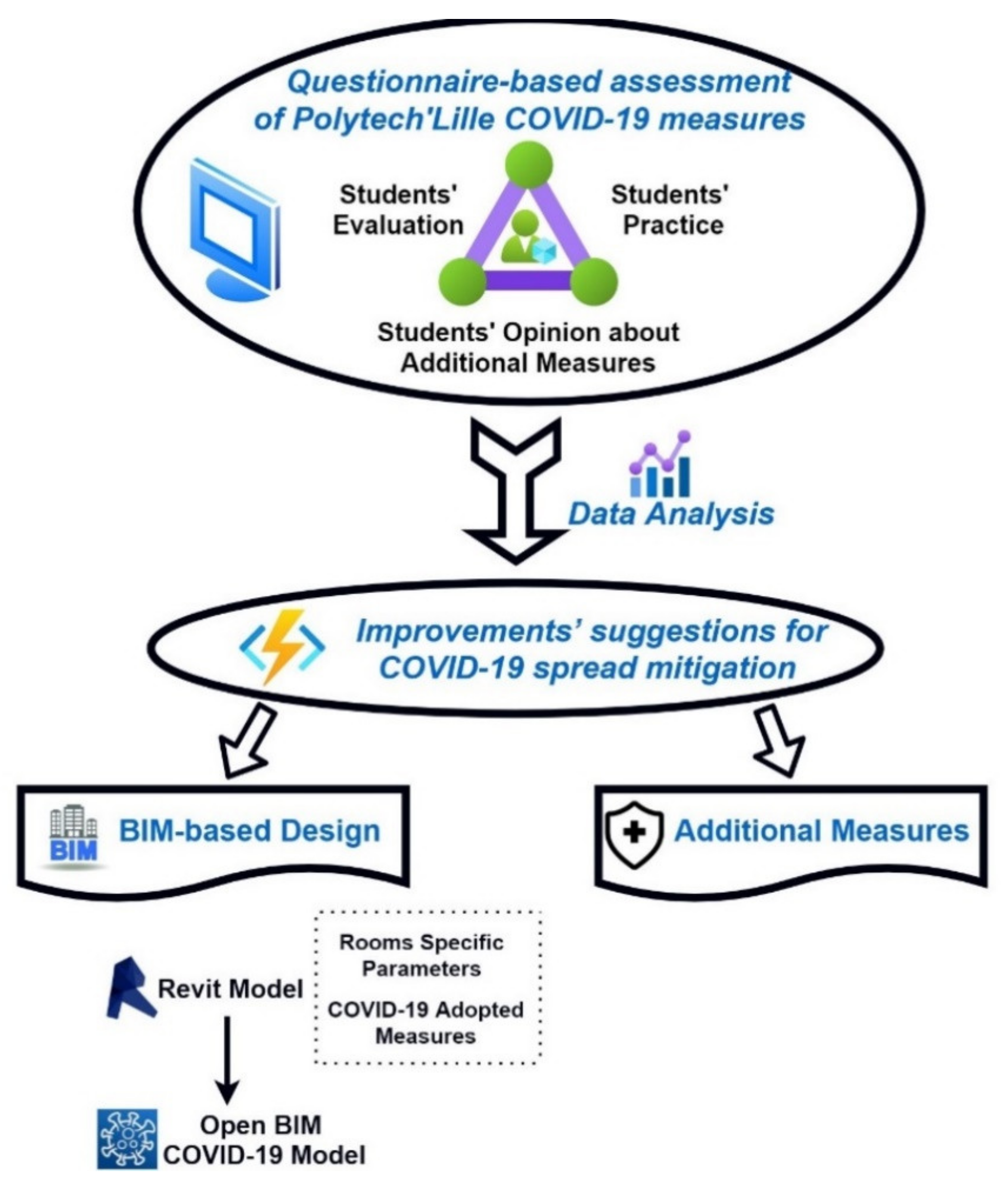
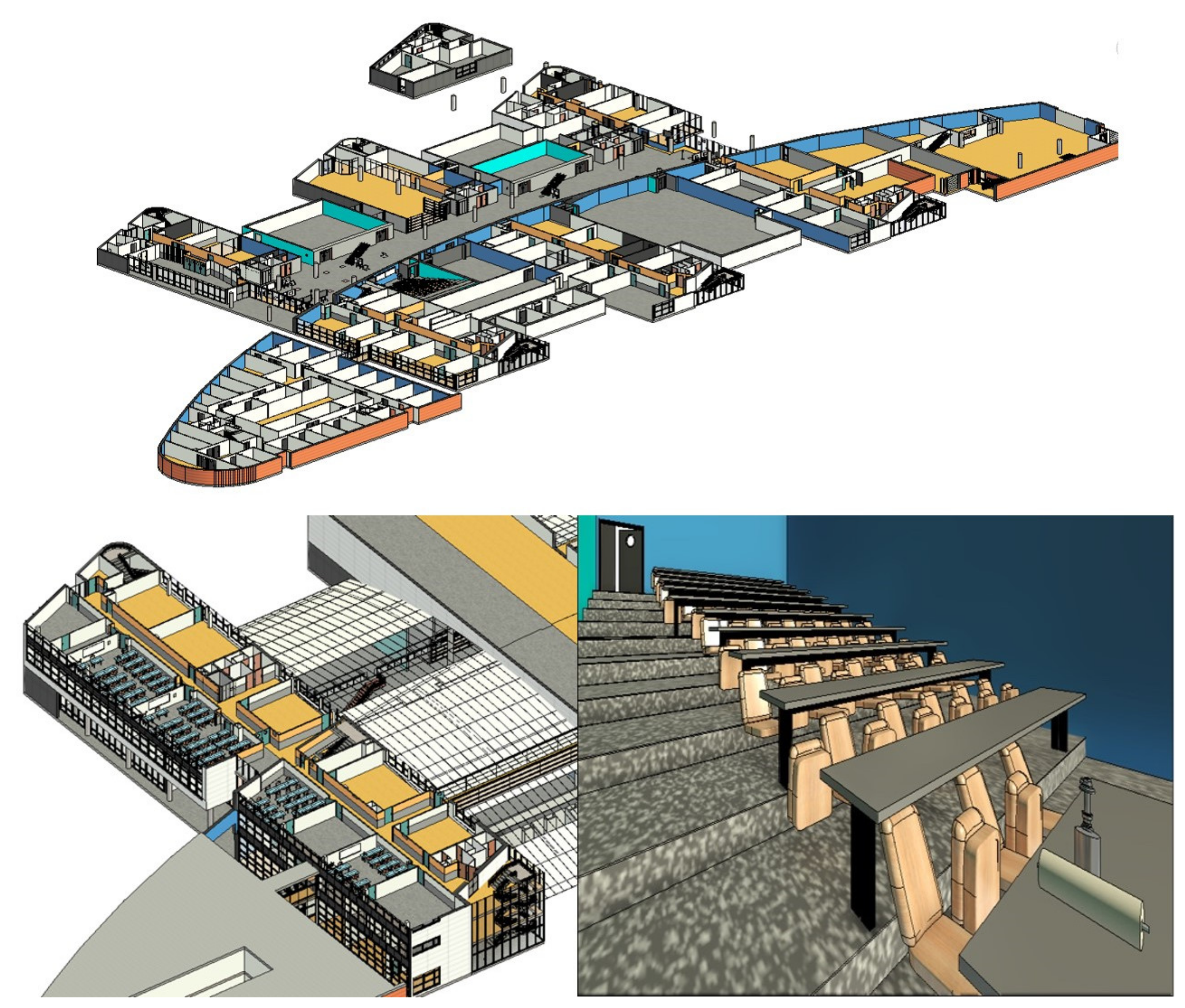
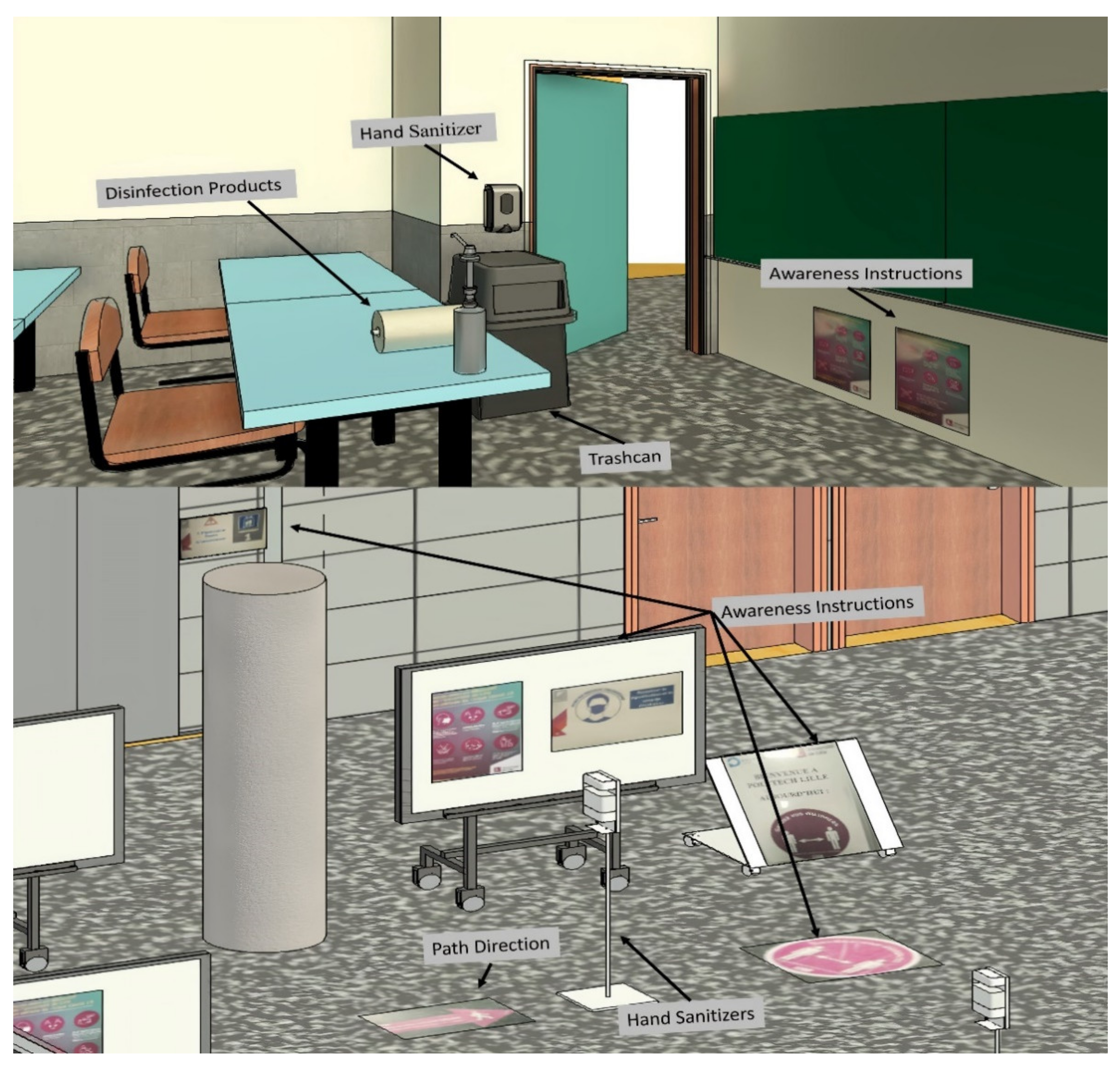
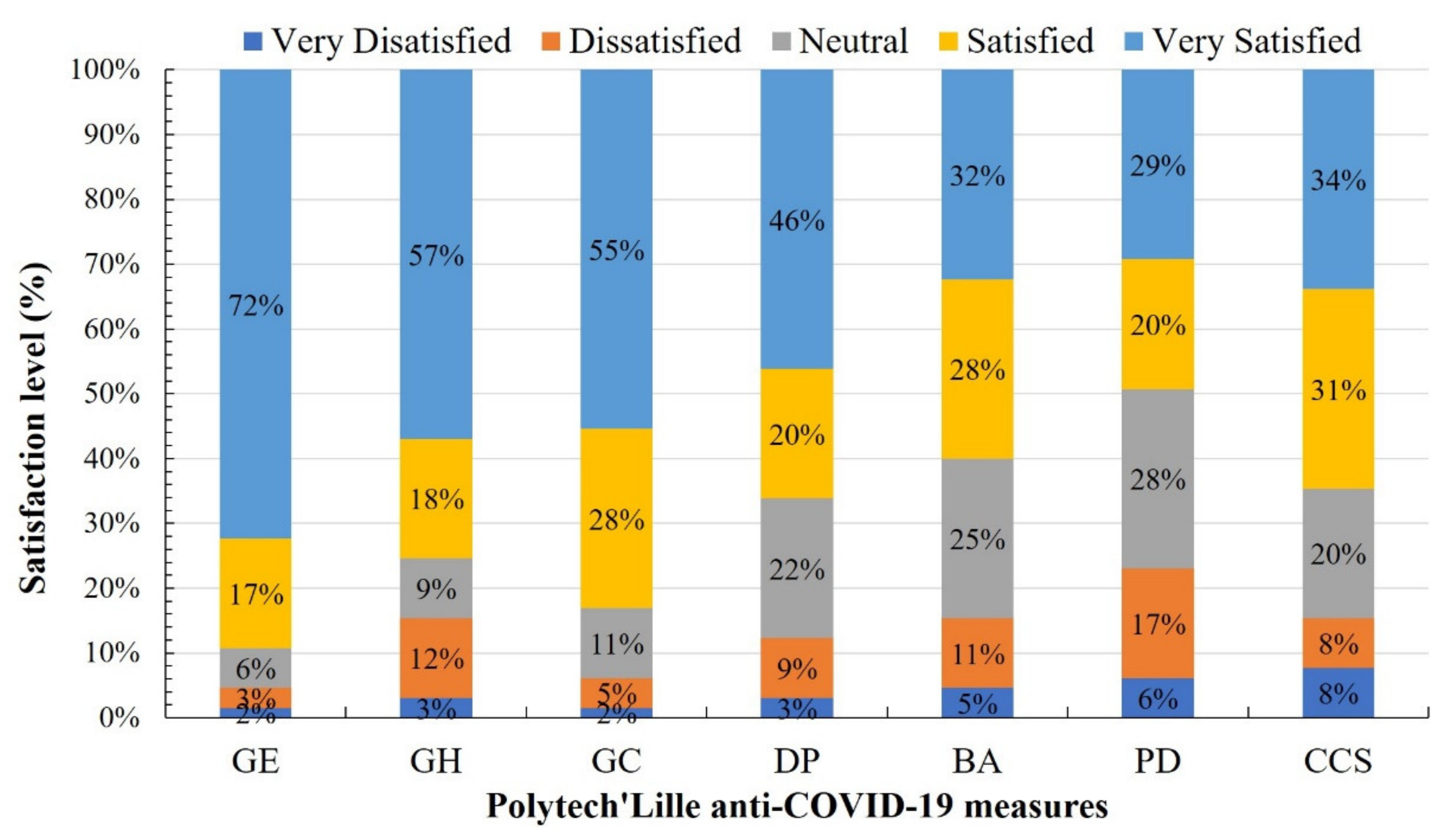
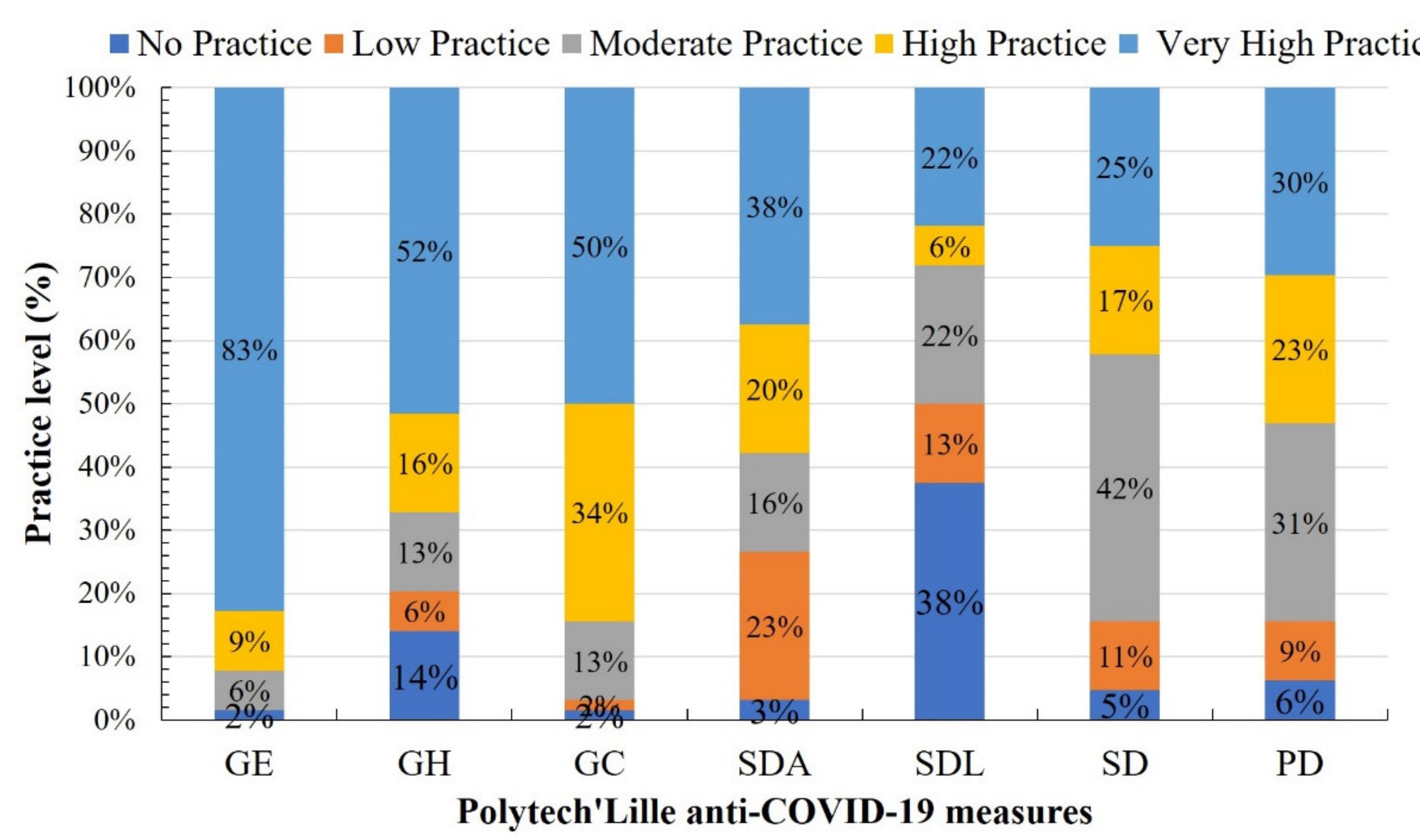
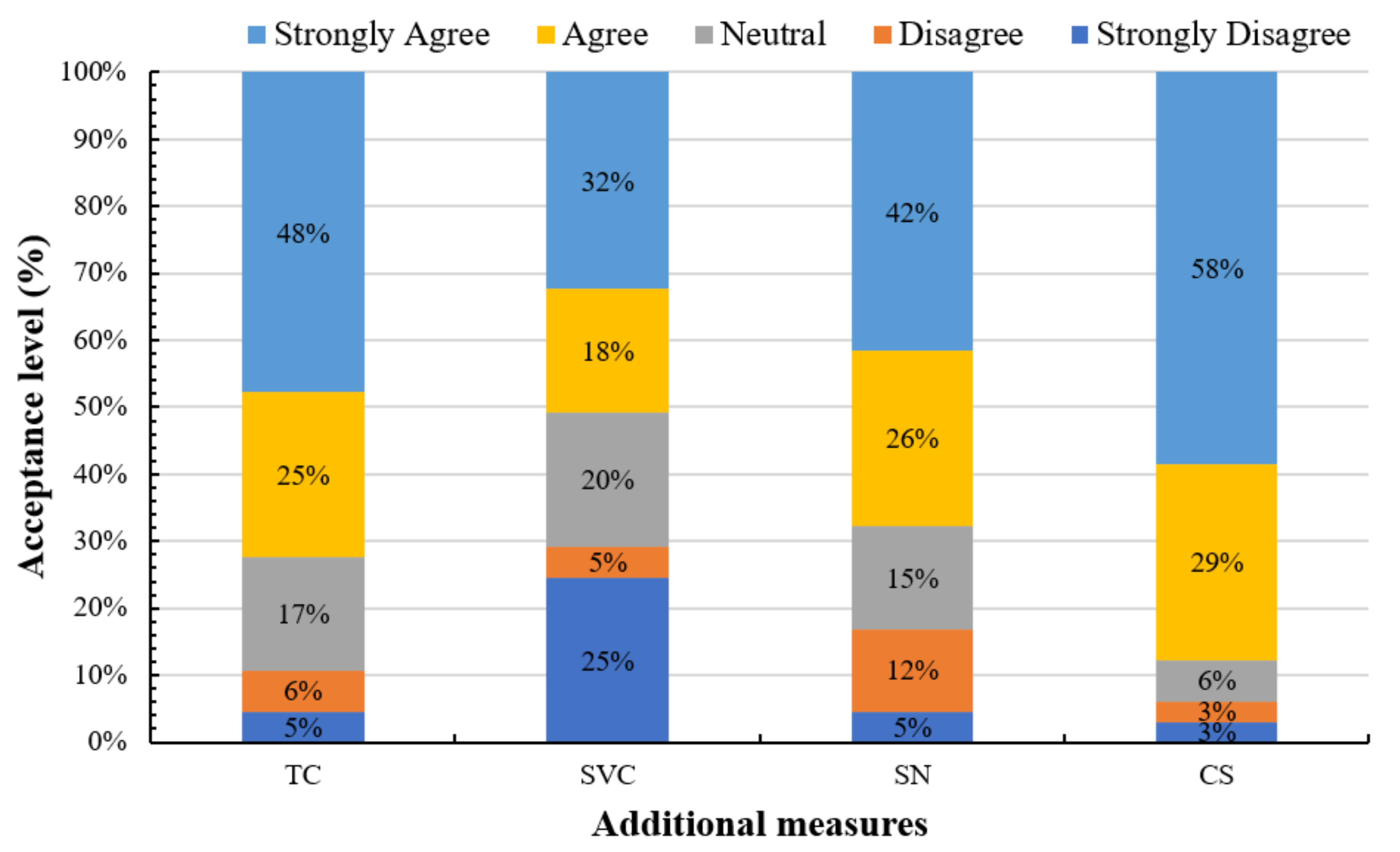
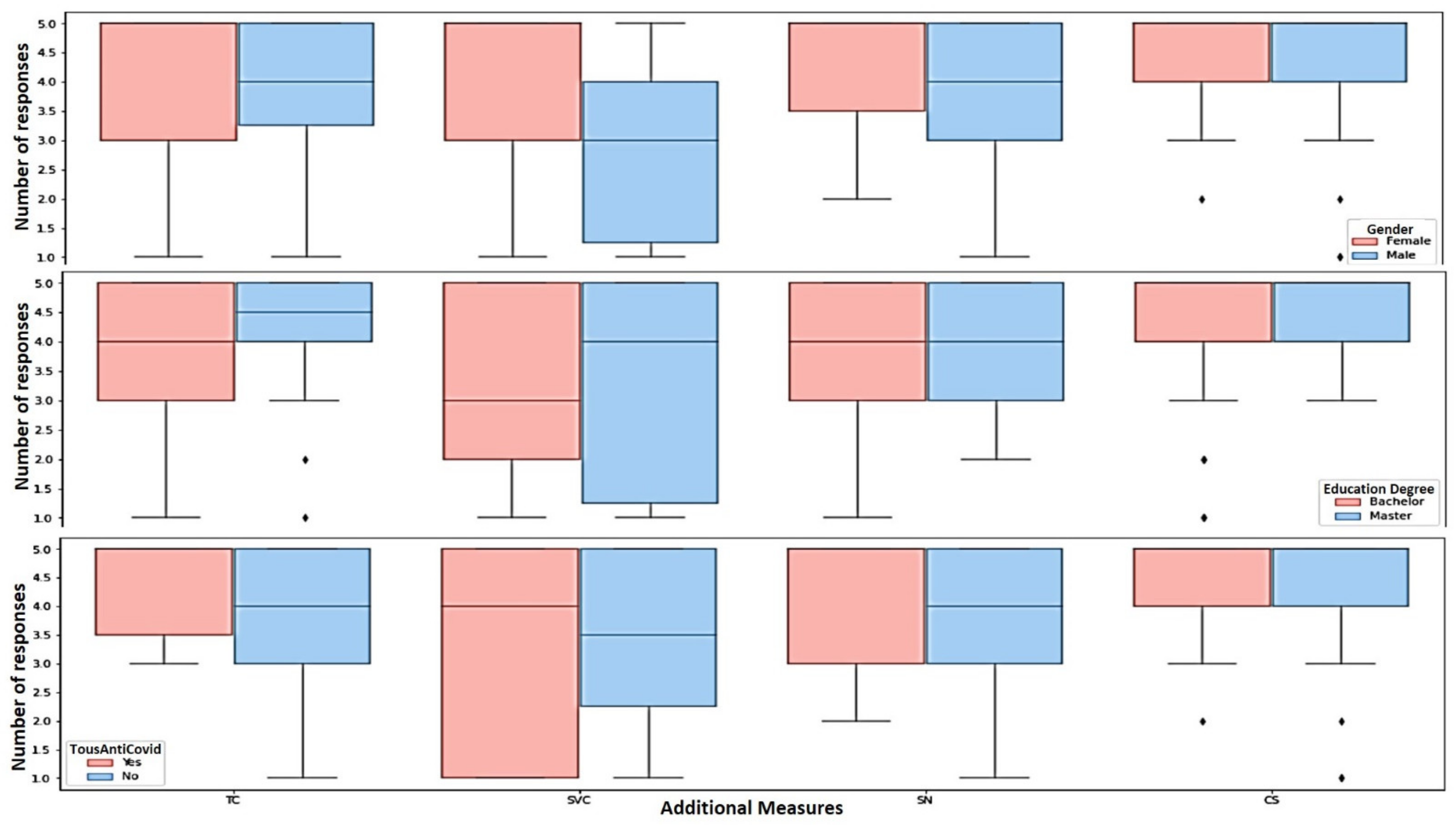
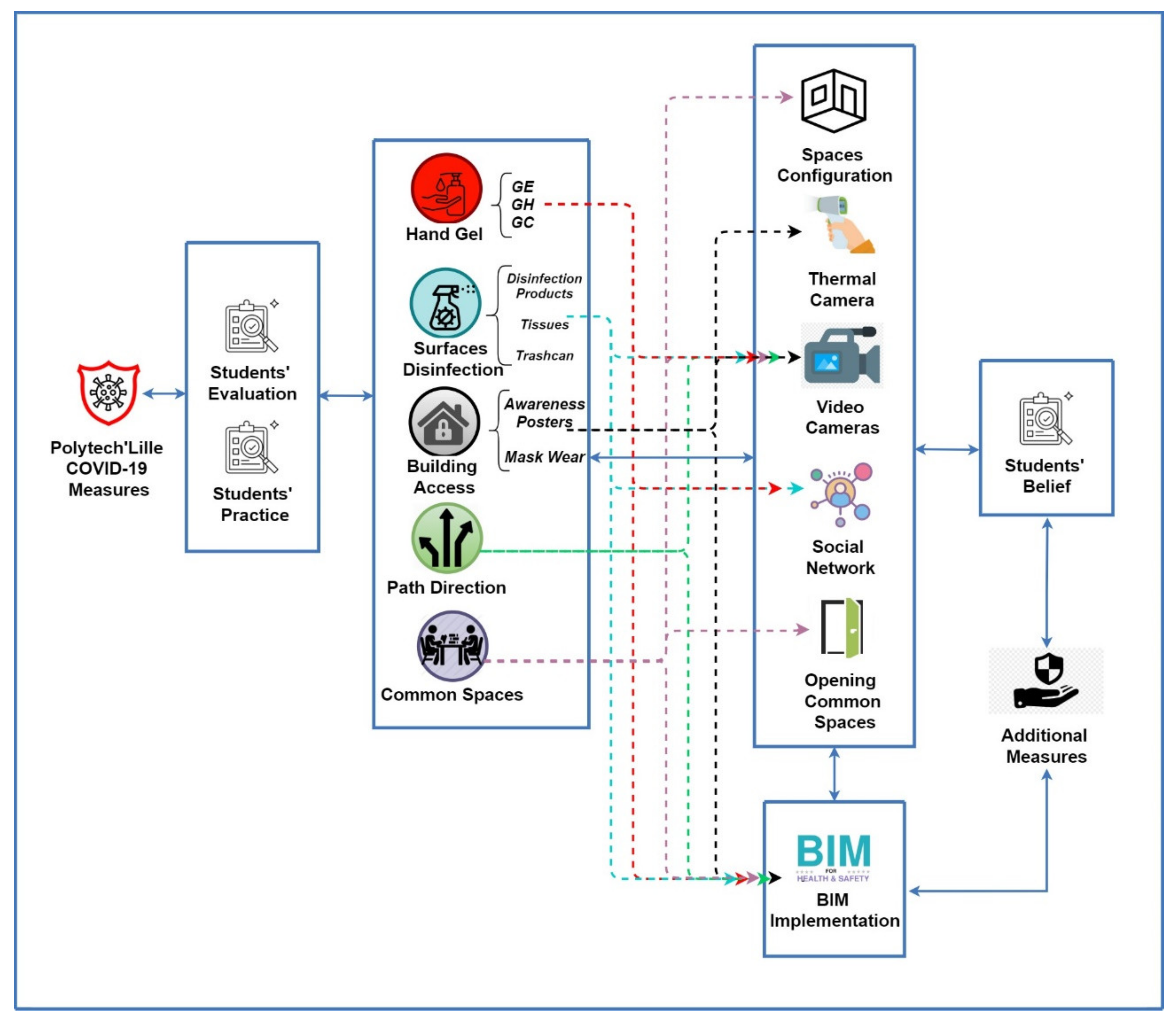
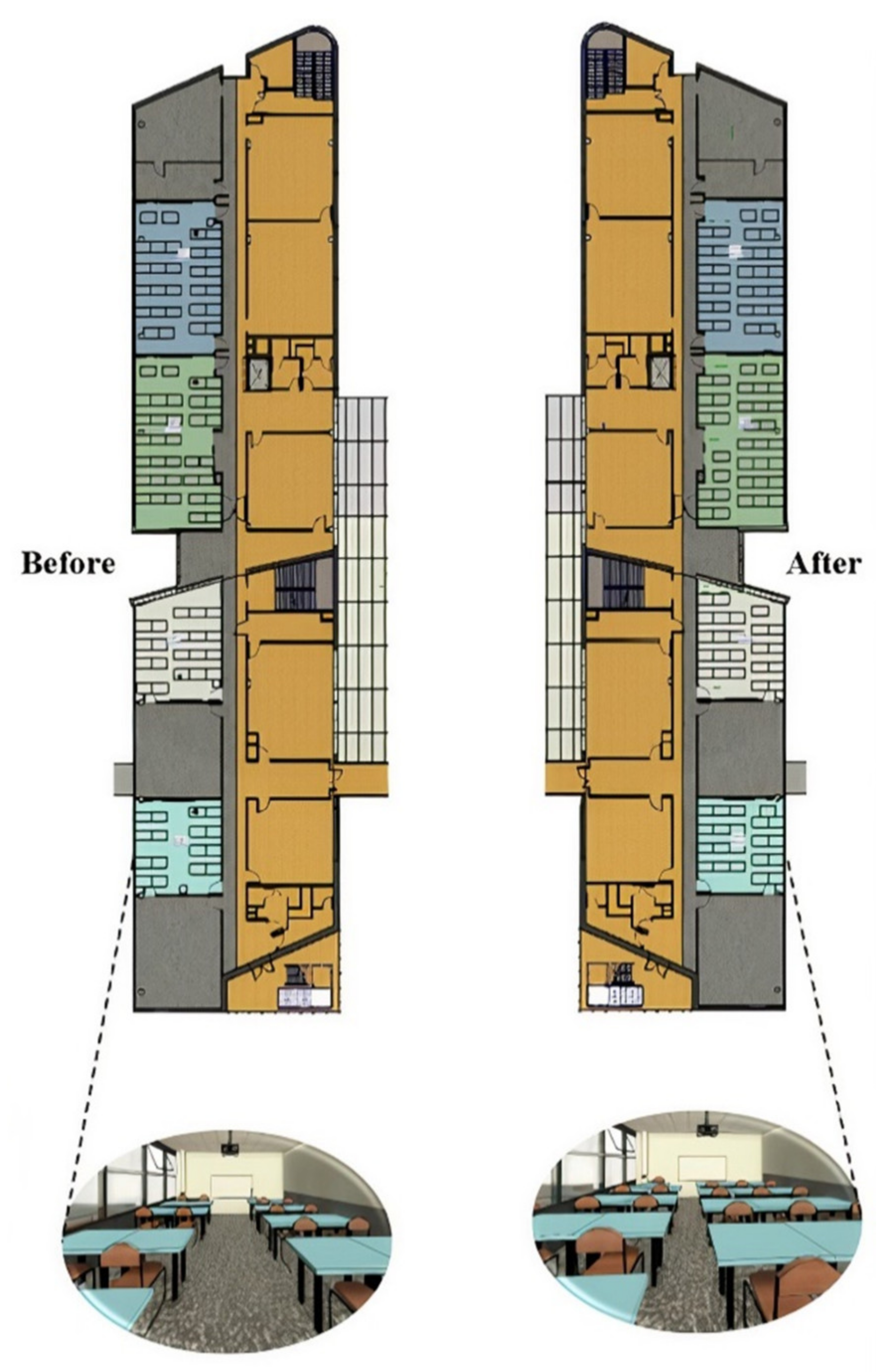
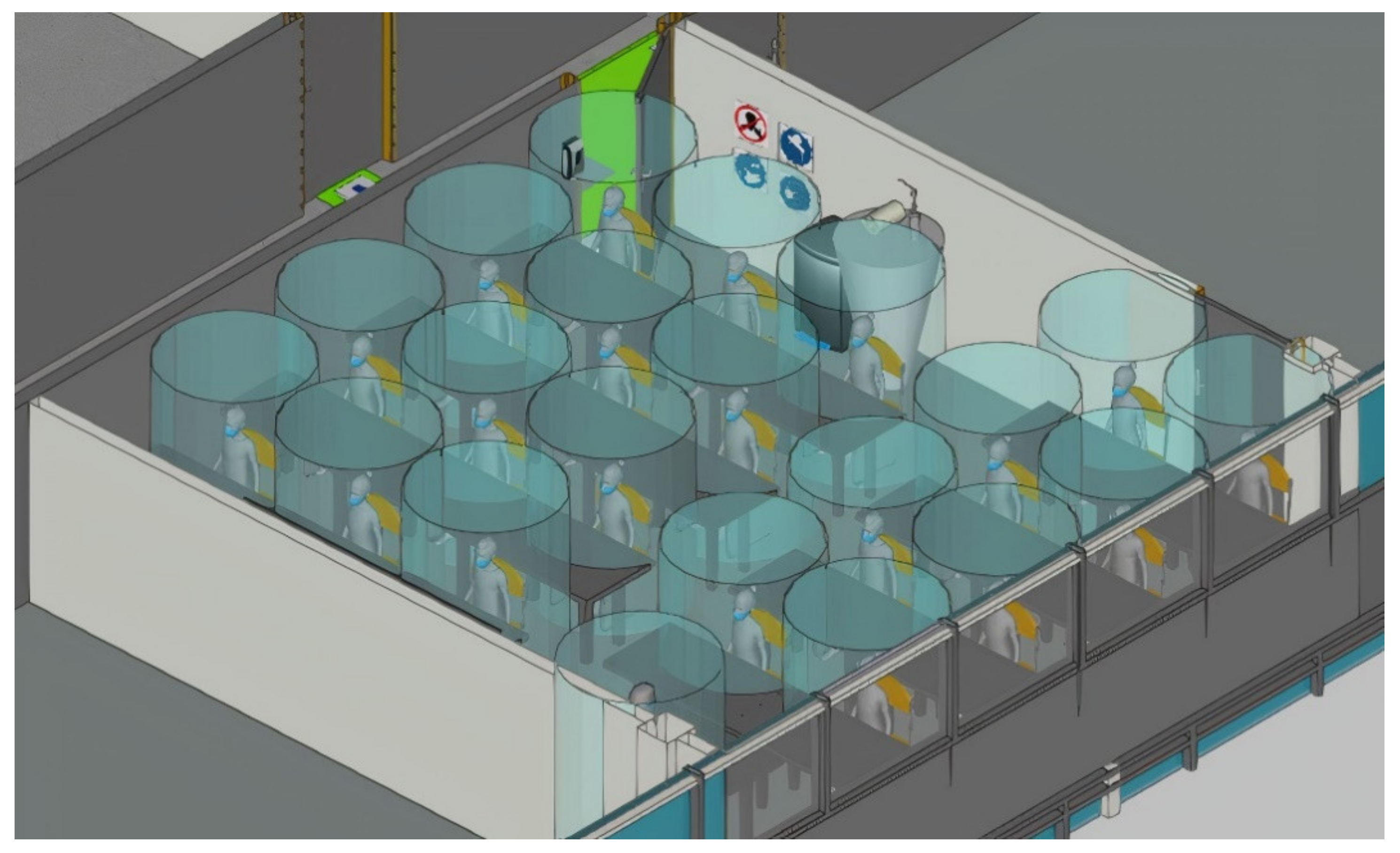

| Questionnaire Parts | Questions |
|---|---|
| Part 1: general information | Gender Education degree (bachelor’s or master’s degree) Use of the mobile application “TousAntiCovid” |
| Part 2: assessing COVID-19 safety measures taken by Polytech’Lille | To what extent do the following measures are efficiently performed in Polytech’Lille? Hand sanitizer at the entrance Hand sanitizer in the hall Hand sanitizer in classrooms Disinfection Products Access restrictions Path direction organization Closure of common areas |
| Part 3: assessing students’ commitment to the COVID-19 safety measures | To what extent are you committed to the following measures? Hand sanitizer at the entrance Hand sanitizer in the hall Hand sanitizer in classrooms Path direction Surfaces Disinfection upon arrival Surfaces Disinfection at the end of the course Social distancing |
| Part 4: Students’ suggestions about additional measures | What is your opinion concerning the implementation of the following additional measures? Thermal camera (without facial recognition) Surveillance cameras (without facial recognition) to verify compliance with measures A social network of information about COVID-19Common spaces available to students while respecting social distancing |
| Characteristic | Total(n = 65), n% | With TousAntiCovid Application (n = 19, 29%) | Without TousAntiCovid Application (n = 46, 71%) | F | p-Value |
|---|---|---|---|---|---|
| Gender | 0.024 | 0.877 | |||
| Female | 23 (35) | 7 (30) | 16 (70) | ||
| Male | 42 (65) | 12 (29) | 30 (71) | ||
| Education Degree | 3.674 | 0.05 | |||
| Bachelor’s | 39 (60) | 8 (21) | 31 (79) | ||
| Master’s | 26 (40) | 11 (42) | 15 (58) |
| Category | Measures | Satisfaction Level (%) | F | p-Value | |||||||||
|---|---|---|---|---|---|---|---|---|---|---|---|---|---|
| 1 | 2 | 3 | 4 | 5 | 1 | 2 | 3 | 4 | 5 | ||||
| Gender | |||||||||||||
| Female | Male | ||||||||||||
| Disinfection Measures | GE | 0 | 4 | 4 | 13 | 78 | 2 | 2 | 7 | 19 | 69 | 4.68 | 0.03 * |
| GH | 4 | 9 | 4 | 13 | 70 | 2 | 14 | 12 | 21 | 50 | |||
| GC | 0 | 0 | 4 | 30 | 65 | 2 | 7 | 14 | 26 | 50 | |||
| DP | 4 | 9 | 13 | 17 | 57 | 2 | 10 | 26 | 21 | 40 | |||
| Access Measures | BA | 9 | 9 | 22 | 22 | 39 | 2 | 12 | 26 | 31 | 29 | 1.58 | 0.21 |
| PD | 4 | 9 | 30 | 13 | 43 | 7 | 21 | 26 | 24 | 21 | |||
| CCS | 9 | 9 | 13 | 17 | 52 | 7 | 7 | 26 | 33 | 26 | |||
| Education Degree | |||||||||||||
| Bachelor’s | Master’s | ||||||||||||
| Disinfection Measures | GE | 3 | 5 | 8 | 15 | 69 | 0 | 0 | 4 | 19 | 77 | 1.19 | 0.27 |
| GH | 5 | 13 | 15 | 18 | 49 | 0 | 12 | 0 | 19 | 69 | |||
| GC | 3 | 5 | 13 | 33 | 46 | 0 | 4 | 8 | 19 | 69 | |||
| DP | 5 | 10 | 18 | 21 | 46 | 0 | 8 | 27 | 19 | 46 | |||
| Access Measures | BA | 5 | 10 | 21 | 26 | 38 | 4 | 12 | 31 | 31 | 23 | 0.36 | 0.55 |
| PD | 5 | 18 | 28 | 15 | 33 | 8 | 15 | 27 | 27 | 23 | |||
| CCS | 8 | 10 | 13 | 28 | 41 | 8 | 4 | 31 | 35 | 23 | |||
| Use of the TousAntiCovid Mobile Application | |||||||||||||
| No | Yes | ||||||||||||
| Disinfection Measures | GE | 2 | 4 | 7 | 20 | 67 | 0 | 0 | 5 | 11 | 84 | 5.11 | 0.02 * |
| GH | 4 | 11 | 11 | 22 | 52 | 0 | 16 | 5 | 11 | 68 | |||
| GC | 2 | 2 | 13 | 33 | 50 | 0 | 11 | 5 | 16 | 68 | |||
| DP | 4 | 9 | 24 | 17 | 46 | 0 | 11 | 16 | 26 | 47 | |||
| Access Measures | BA | 4 | 11 | 26 | 33 | 26 | 5 | 11 | 21 | 16 | 47 | 0.03 | 0.85 |
| PD | 4 | 15 | 28 | 24 | 28 | 11 | 21 | 26 | 11 | 32 | |||
| CCS | 7 | 11 | 13 | 35 | 35 | 11 | 0 | 37 | 21 | 32 | |||
| Category | Measures | Practice Level (%) | F | p-Value | |||||||||
|---|---|---|---|---|---|---|---|---|---|---|---|---|---|
| 1 | 2 | 3 | 4 | 5 | 1 | 2 | 3 | 4 | 5 | ||||
| Gender | |||||||||||||
| Female | Male | ||||||||||||
| Hand Sanitizers | GE | 0 | 0 | 9 | 9 | 83 | 2 | 0 | 5 | 10 | 83 | 0.31 | 0.58 |
| GH | 9 | 9 | 22 | 9 | 52 | 17 | 5 | 7 | 21 | 50 | |||
| GC | 0 | 4 | 9 | 26 | 61 | 2 | 0 | 14 | 40 | 43 | |||
| Surfaces Disinfection | SDA | 9 | 30 | 4 | 22 | 35 | 0 | 19 | 21 | 21 | 38 | 0.88 | 0.35 |
| SDL | 43 | 9 | 22 | 4 | 22 | 33 | 14 | 24 | 7 | 21 | |||
| Distancing Measures | PD | 13 | 4 | 35 | 13 | 35 | 2 | 12 | 31 | 29 | 26 | 0.13 | 0.72 |
| SD | 0 | 9 | 52 | 4 | 35 | 7 | 12 | 36 | 26 | 19 | |||
| Education Degree | |||||||||||||
| Bachelor | Master | ||||||||||||
| Hand Sanitizers | GE | 3 | 0 | 8 | 10 | 79 | 0 | 0 | 4 | 8 | 88 | 9.12 | 0.003 ** |
| GH | 21 | 10 | 8 | 18 | 44 | 4 | 0 | 19 | 15 | 62 | |||
| GC | 3 | 3 | 15 | 41 | 38 | 0 | 0 | 8 | 27 | 65 | |||
| Surfaces Disinfection | SDA | 3 | 26 | 18 | 18 | 36 | 4 | 19 | 12 | 27 | 38 | 3.39 | 0.07 |
| SDL | 46 | 18 | 13 | 5 | 18 | 23 | 4 | 38 | 8 | 27 | |||
| Distancing Measures | PD | 5 | 5 | 31 | 26 | 33 | 8 | 15 | 35 | 19 | 23 | 0.22 | 0.64 |
| SD | 5 | 10 | 44 | 23 | 18 | 4 | 12 | 38 | 12 | 35 | |||
| Use of the TousAntiCovid Mobile Application | |||||||||||||
| No | Yes | ||||||||||||
| Hand Sanitizers | GE | 2 | 0 | 4 | 11 | 83 | 0 | 0 | 11 | 5 | 84 | 4.96 | 0.02 * |
| GH | 17 | 9 | 11 | 22 | 41 | 5 | 0 | 16 | 5 | 74 | |||
| GC | 2 | 2 | 13 | 39 | 43 | 0 | 0 | 11 | 26 | 63 | |||
| Surfaces Disinfection | SDA | 4 | 26 | 15 | 24 | 30 | 0 | 16 | 16 | 16 | 53 | 1.46 | 0.23 |
| SDL | 35 | 13 | 28 | 7 | 17 | 42 | 11 | 11 | 5 | 32 | |||
| Distancing Measures | PD | 7 | 9 | 35 | 24 | 26 | 5 | 11 | 26 | 21 | 37 | 3.83 | 0.05 * |
| SD | 7 | 13 | 41 | 24 | 15 | 0 | 5 | 42 | 5 | 47 | |||
| Measures | Acceptance Level (%) | F | p-Value | |||||||||
|---|---|---|---|---|---|---|---|---|---|---|---|---|
| 1 | 2 | 3 | 4 | 5 | 1 | 2 | 3 | 4 | 5 | |||
| Gender | ||||||||||||
| Female | Male | |||||||||||
| TC | 4 | 9 | 17 | 13 | 57 | 5 | 5 | 16 | 31 | 43 | 4.27 | 0.04 * |
| SVC | 22 | 0 | 9 | 17 | 52 | 26 | 7 | 26 | 19 | 22 | ||
| SN | 0 | 4 | 22 | 22 | 52 | 7 | 17 | 12 | 28 | 36 | ||
| CS | 0 | 4 | 4 | 40 | 52 | 5 | 2 | 7 | 24 | 62 | ||
| Education Degree | ||||||||||||
| Bachelor’s | Master’s | |||||||||||
| TC | 5 | 7 | 21 | 21 | 46 | 4 | 4 | 11 | 31 | 50 | 1.32 | 0.25 |
| SVC | 23 | 5 | 26 | 15 | 31 | 27 | 4 | 11 | 23 | 35 | ||
| SN | 8 | 13 | 13 | 25 | 41 | 0 | 11 | 19 | 27 | 43 | ||
| CS | 5 | 5 | 5 | 26 | 59 | 0 | 0 | 7 | 35 | 58 | ||
| Use of the TousAntiCovid Mobile Application | ||||||||||||
| No | Yes | |||||||||||
| TC | 6 | 9 | 13 | 26 | 46 | 0 | 0 | 26 | 21 | 53 | 0.38 | 0.54 |
| SVC | 20 | 6 | 24 | 20 | 30 | 37 | 0 | 10 | 16 | 37 | ||
| SN | 6 | 15 | 11 | 31 | 37 | 0 | 5 | 26 | 16 | 53 | ||
| CS | 4 | 2 | 4 | 29 | 61 | 0 | 5 | 11 | 31 | 53 | ||
| Rooms | Initial Capacity | Capacity According to Anti-COVID-19 Measures | Optimized Capacity Using BIM (OBC-19) | Increase in the Capacity (%) |
|---|---|---|---|---|
| Amphi LeBon | 120 | 60 | 60 | 0 |
| A 203 | 32 | 15 | 20 | 33 |
| A 207 | 42 | 18 | 21 | 17 |
| A 209 | 60 | 32 | 32 | 0 |
| A 211 | 59 | 26 | 28 | 7 |
| A 306 | 22 | 13 | 15 | 15 |
| A 319 | 68 | 49 | 24 | 29 |
Publisher’s Note: MDPI stays neutral with regard to jurisdictional claims in published maps and institutional affiliations. |
© 2021 by the authors. Licensee MDPI, Basel, Switzerland. This article is an open access article distributed under the terms and conditions of the Creative Commons Attribution (CC BY) license (https://creativecommons.org/licenses/by/4.0/).
Share and Cite
Wehbe, R.; Shahrour, I. Assessment and Improvement of Anti-COVID-19 Measures in Higher Education Establishments. Sustainability 2021, 13, 5989. https://doi.org/10.3390/su13115989
Wehbe R, Shahrour I. Assessment and Improvement of Anti-COVID-19 Measures in Higher Education Establishments. Sustainability. 2021; 13(11):5989. https://doi.org/10.3390/su13115989
Chicago/Turabian StyleWehbe, Rania, and Isam Shahrour. 2021. "Assessment and Improvement of Anti-COVID-19 Measures in Higher Education Establishments" Sustainability 13, no. 11: 5989. https://doi.org/10.3390/su13115989
APA StyleWehbe, R., & Shahrour, I. (2021). Assessment and Improvement of Anti-COVID-19 Measures in Higher Education Establishments. Sustainability, 13(11), 5989. https://doi.org/10.3390/su13115989







